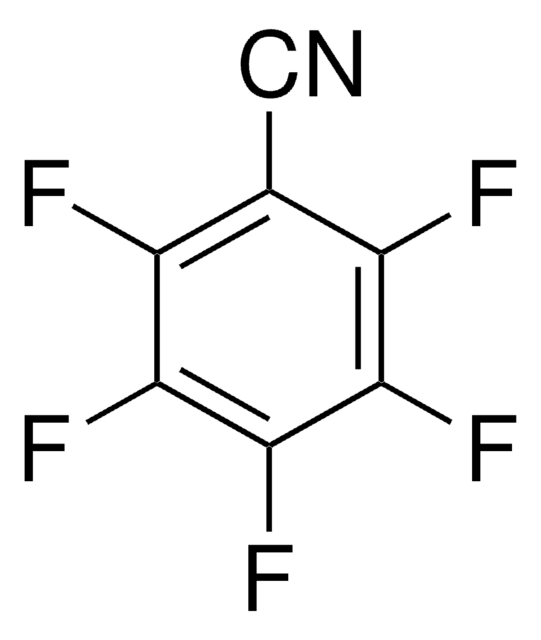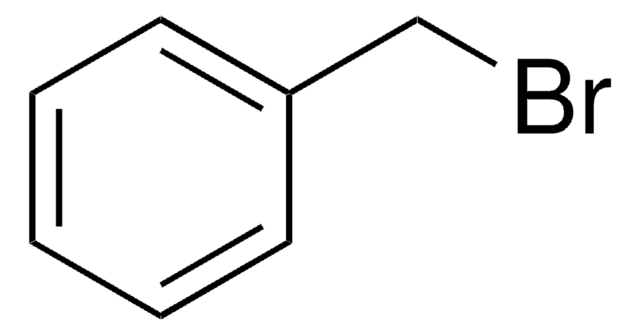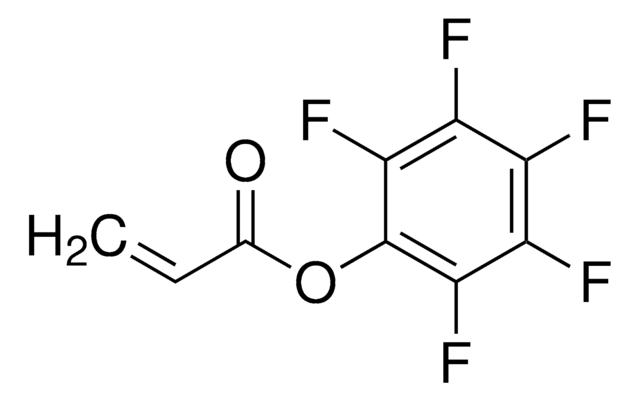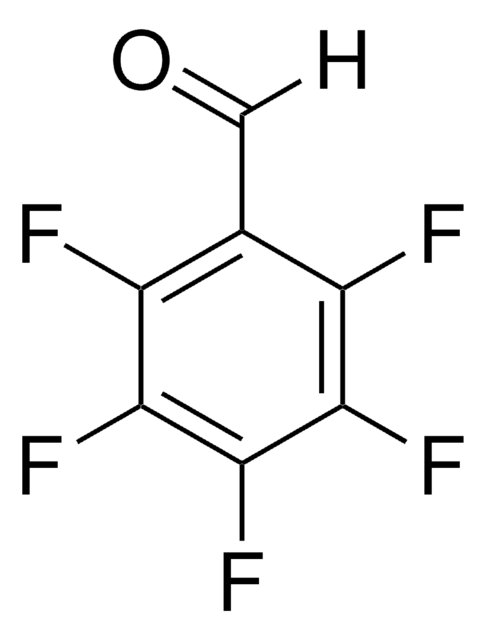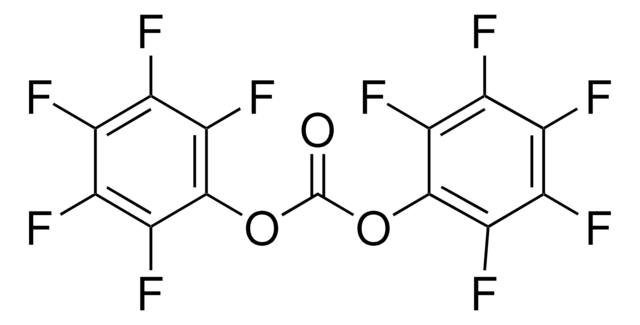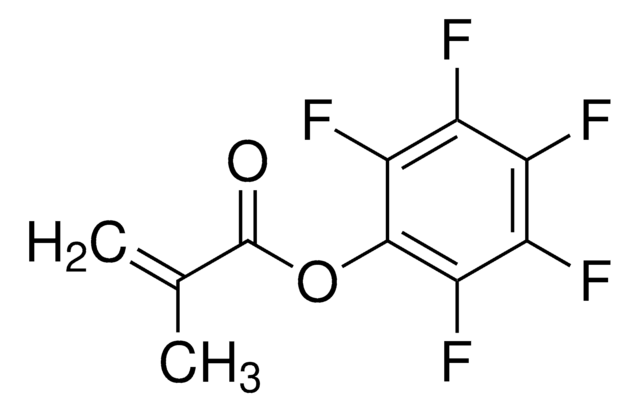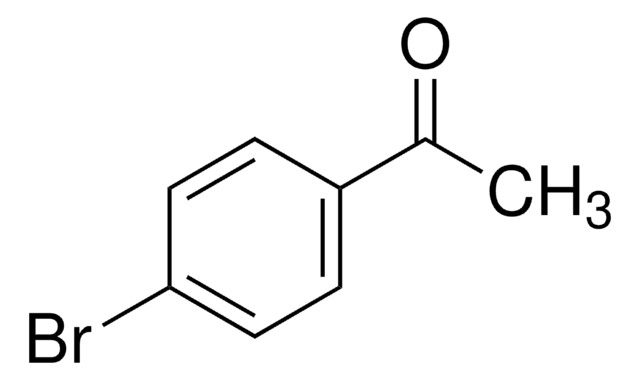Wszystkie zdjęcia(2)
Kluczowe dokumenty
About This Item
Wzór liniowy:
C6F5CO2CH3
Numer CAS:
Masa cząsteczkowa:
226.10
Numer MDL:
Kod UNSPSC:
12352100
Identyfikator substancji w PubChem:
NACRES:
NA.22
Polecane produkty
Próba
99%
Formularz
liquid
współczynnik refrakcji
n20/D 1.431 (lit.)
gęstość
1.532 g/mL at 25 °C (lit.)
grupa funkcyjna
ester
fluoro
ciąg SMILES
COC(=O)c1c(F)c(F)c(F)c(F)c1F
InChI
1S/C8H3F5O2/c1-15-8(14)2-3(9)5(11)7(13)6(12)4(2)10/h1H3
Klucz InChI
UXJRQNXHCZKHRJ-UHFFFAOYSA-N
Powiązane kategorie
Zastosowanie
Pentafluorobenzoesan metylu został wykorzystany do przygotowania fotosprzęgacza, opartego na perfluorofenyloazidu (PFPA) - sprzężonej polialaminie, do skutecznej immobilizacji polimerów, nanocząstek, grafenu i małych cząsteczek. Został on również wykorzystany do przygotowania fotoaktywnego odczynnika N-hydroksysukcynoimidu(NHS)-PFPA.
Ta strona może zawierać tekst przetłumaczony maszynowo.
Hasło ostrzegawcze
Warning
Zwroty wskazujące rodzaj zagrożenia
Zwroty wskazujące środki ostrożności
Klasyfikacja zagrożeń
Eye Irrit. 2 - Skin Irrit. 2 - STOT SE 3
Organy docelowe
Respiratory system
Kod klasy składowania
10 - Combustible liquids
Klasa zagrożenia wodnego (WGK)
WGK 3
Temperatura zapłonu (°F)
172.4 °F - closed cup
Temperatura zapłonu (°C)
78 °C - closed cup
Środki ochrony indywidualnej
Eyeshields, Gloves, type ABEK (EN14387) respirator filter
Wybierz jedną z najnowszych wersji:
Masz już ten produkt?
Dokumenty związane z niedawno zakupionymi produktami zostały zamieszczone w Bibliotece dokumentów.
Klienci oglądali również te produkty
Huibin Wang et al.
Bioconjugate chemistry, 22(1), 26-32 (2010-12-09)
A universal photochemical method has been established for the immobilization of intact carbohydrates and their analogues, and for the fabrication of carbohydrate microarrays. The method features the use of perfluorophenyl azide (PFPA)-modified substrates and the photochemical reaction of surface azido
Takuya Kubo et al.
Langmuir : the ACS journal of surfaces and colloids, 27(15), 9372-9378 (2011-06-28)
A highly efficient photocoupling agent, based on perfluorophenylazide (PFPA)-conjugated polyallylamine (PAAm), was developed for the efficient immobilization of polymers, nanoparticles, graphene, and small molecules. The conjugate, PAAm-PFPA, was synthesized, and the percentage of the photoactive moiety, PFPA, can be controlled
Marllyn Marques da Silva et al.
Regulatory toxicology and pharmacology : RTP, 103, 282-291 (2019-02-23)
The fibrinolytic enzyme produced by Mucor subtilissimus UCP 1262 was obtained by solid fermentation and purified by ion exchange chromatography using DEAE-Sephadex A50. The enzyme toxicity was evaluated using mammalian cell lineages: HEK-293, J774.A1, Sarcoma-180 and PBMCs which appeared to
Na Kong et al.
Carbohydrate research, 405, 33-38 (2015-03-10)
Carbohydrate-functionalized single-walled carbon nanotubes (SWNTs) were synthesized using microwave-assisted reaction of perfluorophenyl azide with the nanotubes. The results showed that microwave radiation provides a rapid and effective means to covalently attach carbohydrates to SWNTs, producing carbohydrate-SWNT conjugates for biorecognition. The
Nasz zespół naukowców ma doświadczenie we wszystkich obszarach badań, w tym w naukach przyrodniczych, materiałoznawstwie, syntezie chemicznej, chromatografii, analityce i wielu innych dziedzinach.
Skontaktuj się z zespołem ds. pomocy technicznej
